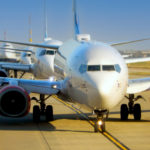Aerospace is facing more challenges than ever before – Alan Peaford shares his concerns on how the woes just keep piling on.
This was the summer of our discontent, but with no glorious winter in prospect, I worry how our aerospace and aviation industry will weather the continuing storms that batter us.
Willie Walsh, the secretary general and CEO of the global airlines’ association IATA is not a man to mince his words. In his days as head of British Airways he was often critical of the UK’s largest airport, London Heathrow, and at the Farnborough Airshow in July he was pulling no punches.
“Idiots,” he said. IATA and leading international airlines such as Emirates had advised the UK and other European airport companies about the faster-than-expected recovery from the Covid pandemic that had brought the passenger airline market to its knees.
Emirates president ‘irate’
But according to Sir Tim Clark, the Emirates president and Walsh at the Airline Leaders session at Farnborough, the message had fallen on deaf ears. The airports were demanding airlines cut flights and passenger numbers.
“The operation of Emirates was heavily compromised,” Sir Tim said.
“This is anathema to what we do in this industry. And it has to be better managed, I was pretty irate, because I’ve never seen this in my entire professional career,” he added.
Describing the airport management as “idiots”, Walsh said Heathrow had been fixated on the regulatory review and trying to push up prices by arguing the UK passenger recovery would be slower.
The airlines were predicting 72 million passengers at Heathrow this year. While some commentators were talking about a dearth of air travel in the wake of Covid, the airlines were seeing advance bookings coming in as families – and businesses – wanted to get back to in-person meetings.
Summer bookings
In fact, the summer bookings in particular were pushing Heathrow towards a probable 79.8 million passenger number. But the airport stuck to its guns and worked on a projected 43.2 million. The regulator, the CAA, was predicting 45.6 million.
The queues often more than four hours to get out of – and back into – Heathrow and other airports such as Schiphol saw many members of the public targeting the airlines for their wrath. Staff shortages – the result of lay-offs during the Covid period; failure to re-hire or recruit and a possible belief that there was a patchy future for the industry along with lack of training or security clearances added to the problem.
Since the peak summer problems there are signs that airport and airline industries are pushing aside the blame game and working together to address the underlying causes which has seen estimates for the recovery to pre-2019 numbers be put back until at least 2024.
Staff shortages
Staff shortages are the key. But how do we attract people back. Ground handling is at the heart of the problem. Pay is relatively low and there are unsocial working hours.
The airport industry’s head, Luis Felipe de Oliveira, director general of ACI World, said the pressure from airlines to keep costs down is one of several reasons why it is difficult for airports and other service providers to pay their workers more as they attempt to resolve the staffing shortages.
“The pressure of costs from airlines, together with the pandemic, together with the lack of support for airports during the pandemic, creates this situation,” he said. That rolls over to other areas like airlines, those directly employed by airports, or those working in border control, customs, ground-handling and so on, all adding to the recruitment challenge.
Industry headwinds
Weak currencies against the dollar and predictions of recession in key markets are adding to the list of industry headwinds. Of course, the unions have seen this opportunity and with inflation and rising cost-of-living are calling for strikes, thus adding to the disruption.
De Oliveira has called for governments, suppliers, airlines and airports all needing to work together as the malaise slips down further into the supply chain.
Higher fuel prices are impacting ticket prices with a shortage of jet fuel (most refineries halted production during the pandemic as air travel ceased and haven’t yet re-started). The jet fuel price is currently 50 per cent higher than crude oil prices.
Aerospace analysts are beginning to warn about the stability of small SMEs, claiming that rising interest rates and labour costs are hitting suppliers at time when they need cash to expand.
Some large suppliers, such as tier one suppliers, have received advance payments from the major OEMs, but the smaller sub-tier suppliers are at the end of government support funding and finding difficulty accessing capital at a time when the majors are calling on them to ramp up.
Supply chain problems
It is no secret that both Boeing and Airbus are anxious to ramp up production to meet demand for narrow-body aircraft (the push for improved sustainable performance is a factor) and pressing the supply chain at a time when suppliers are seeking to conserve cash while recognising they need more money to expand.
Engine makers have been seen as a major bottleneck for the deliveries of Max and Neo aircraft with cast and forged engine components the main issue.
Safran CEO Olivier Andries predicts the middle of 2023 before the propulsion providers are back on track.
So with a drop in supply of aircraft; a lag between recruitment and getting staff on the job; and a lack of competitiveness in the job market; the winter gloom could continue.
Embracing technology
The industry, as a whole, needs to focus on its attractiveness and perhaps increasing technology solutions to improve productivity.
It is estimated that only around 25 per cent of the workers laid off during the pandemic are returning.
We need to stop training the way we have trained in the past. Sitting in a classroom with a book just doesn’t cut it anymore. We need different ways to appeal to the demographic we are targeting and begin using more online and competency-based training.
Bright skies by next summer, then innovation on the ramp, improvements in training, and an industry-wide promotion for aerospace careers will be keys to a clearer future.
Subscribe to the FINN weekly newsletter

